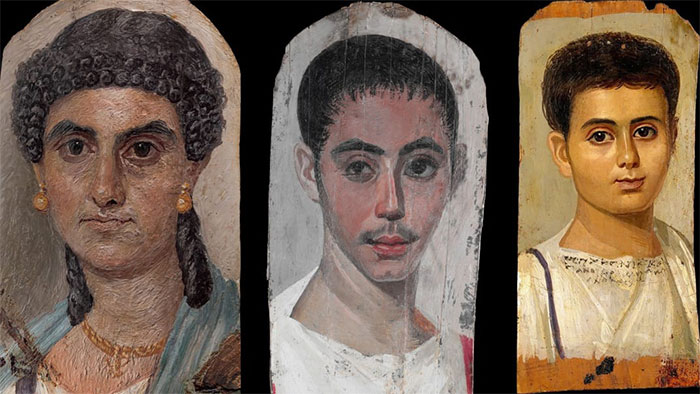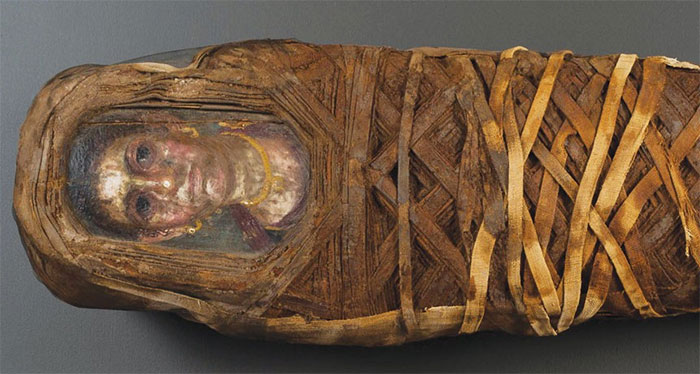Mysterious portraits of ancient Egyptian mummies
Today, worldwide there are only about 1000 portraits of ancient Egyptian mummies. The works were all used to cover the mummy's face, perhaps a way to remember the old man who died.
Portrait of ancient Egyptian mummy is a drawing of the real life of the embalmed body. They were painted on the surface of extremely thin wooden planks, depicting details, vividly like real human faces.

Portrait of an ancient Egyptian mummy.
Could not analyze soon because of lack of sample
If you feel suspicious of the phrase "mummy portraits" , it is irresponsible, because most of the Egyptian mummies we know are no longer "present". Around the end of the 19th century, in an era of massive archaeological excavations and grave ravages, most of them were ripped off by mummies from the face of the mummy and thrown away.
In fact, since the 19th century, interested people have been able to decipher meaning portraits of mummy portraits. However, because they are always slower than grave thieves who don't care about the old wooden slices, they only gathered a small amount of samples.

Used to cover the mummy's face.
At that time there were no machines, modern equipment to help scan and analyze materials as easily as now. Wanting to look carefully also means crushing them first. Because the number of mummy portraits is too small, they cannot be arbitrarily harassed, they are forced to give up.
Over time, precious mummy portraits from Egypt are scattered throughout the world. Approximately 1000 sheets are estimated.
In 2003, Marie Svoboda, a specialist of the Getty Museum in Los Angeles, USA, decided to carry out the decoding of the portrait of an ancient Egyptian mummy. Unfortunately, there are only 16 photos in the museum.
After 10 years of efforts, Svoboda finally succeeded in establishing the APPEAR national organization - Ancient Painting: Ancient Panel Paintings, Exam, and Research. Since the launch of the action, APPEAR has been collaborated by 41 organizations around the world, and "gathered" about 285 portraits.

Ancient portraits of Egypt are most likely to be influenced by Greek culture of art.
May be of Greek origin
It can be affirmed that the mummified culture in Egypt belongs to Egypt completely. This culture was practiced from thousands of BC (BC), at least from 3300 BC. However, portraits painted on the face of mummies are only carried out after AD, around 100-300 years.
Back in Egypt in the years close to the Yuan, you will see this land in the colonial fate. In 332 BC, Alexander the Great (356–323 BC) of Greece led the invasion, placing Egypt under the rule. The Greek period of Egypt lasted more than 300 years, until 30 BC.

Describe in detail and vividly the appearance of the embalmed object.
Also in the era of Greek Egypt, in Greece, the art of painting was prevailing. People love painting, sculpture and hanging pictures in the house.
All 285 APPEAR mummy portraits date from about 100 to 300. They can very well be influenced by Greek culture of art.
Most imported materials, portraying the master portrait
After scanning X-rays and ultraviolet rays, APPEAR suddenly realized that most of the wooden planks used to paint portraits of mummies were Tilia , a plant only found in Northern Europe .
They also found the red material originated from Spain. It seems that since this era, trade has been very open.

Use Tilia wood from Northern Europe to make drawings
The main color used to paint mummy portraits is indigo. They may have been mass produced, using recycled by-products from the textile industry.
Glue color (paint made of color mixed with yolk or egg white and water) is the most popular drawing material. There are also yellow leaves and colored waxes.
Every mummy portrait depicts a human face between the ages of 20-40. This does not mean that only young people are portrayed, but originally the ancient inhabitants only lived that much.
The results of CT scans also indicated that the pre-death age of mummies corresponding to the age is indicated by portrait painting. Because every face on a portrait of a mummy is youthful and energetic and has eyes that are wide open, the APPEAR guesses that they are all painted before the subject dies. Each portrait is a different face, so they are definitely the master's drawing.

Each portrait is a different face, so they are definitely the master's drawing.
There are still many unanswered mysteries
Up to now, APPEAR has spent 6 years diligently studying, analyzing and explaining. However, what they discovered was just the surface of the iceberg.
By comparison, APPEAR found that many mummy portraits have similarities in drawing style. But they still have not enough data to confirm whether these paintings are drawn by the same artist or the same studio or painting school?
In addition, APPEAR still does not know how many different mummy portraits techniques are there? They are not good, is there any difference between drawing women and men mummies?
Although there are many questions but APPEAR has successfully realized, mummy portraits also represent stratification in ancient Egyptian society. The elite are drawn by more precious materials, such as wax and gold leaves. The rest is only painted with glue.
Previously, the researchers thought that only great characters could paint portraits, covering the mummy's face. But APPEAR discovered foreign imported Tilia wood, and there were some pieces of local wood or recycled wood. Therefore, the subject of portrait painting may be wider than speculation.
- Egyptian mummy floating on the canal
- Shocking discovery of Egyptian mummies
- Discover dozens of mummies in ancient Egyptian tombs
- Successfully deciphered the tiny red face of ancient Egypt
- Egypt discovered nearly 60 mummies during the New Kingdom period
- Add new findings from ancient Egyptian mummies
- Excavation of ancient Egyptian tombs 2300 years old - at least 17 high-level mummies were found
- The most exotic ancient mummies in Vietnam
- Archeology of mummified dog in ancient Egypt
- Discovered the ancient Egyptian mummy almost intact
- Egyptian mummy revealed the pollution in ancient times
- Decode the mystery of the Egyptian mummy collar
 'Fine laughs' - Scary and painful torture in ancient times
'Fine laughs' - Scary and painful torture in ancient times The sequence of numbers 142857 of the Egyptian pyramids is known as the strangest number in the world - Why?
The sequence of numbers 142857 of the Egyptian pyramids is known as the strangest number in the world - Why? Miracle behind the world's largest stone Buddha statue
Miracle behind the world's largest stone Buddha statue What is alum?
What is alum?